Impact on plant communities


In order to assess the changes caused by human activities, effective and reliable monitoring systems are required to recognize and predict hazardous effects. Biological methods can be successfully applied in predicting the impact of human activities particularly of pollutants well in advance since they present effective and reliable method of evaluating the effect of anthropogenic substances on the living organisms. Thus microbes, plants, animals, populations, biotic communities and ecosystems show different levels of sensitivity and can be successfully employed as ecological indicators (bio-indicators) to asses and predict environmental changes in a timely manner.
It is thus evident that every plant is a product of the conditions under which it grows and is therefore, a measurement of environment. Dominant species in an area are most important indicators, as they receive the full impact of the habitat for over long-periods. Consequently, plant communities are more reliable indicators than individual plants. Plants are indicators of conditions, processes and uses. Large species serve as better indicators than small species.
For the past few years, attention has focused on the possible impact of climatic changes on vegetation in Saudi Arabia. Disturbances in the environment can be natural or man-made. Natural disturbances, on plant communities are an integral part of the pattern in most parts of the Kingdom’s landscapes. The natural growth of plant communities will depend on the capacity of various habitats to cope with the rate of warming and increased climate variability as well as on their ability to counter low water availability and increased risk from competition, overgrazing and other disturbances such as unsustainable use, fire, etc. Adverse effects of climate on communities would definitely have serious ramifications for the security and integrity of our natural resources. The overall climatic change in Saudi Arabia or in the Middle East in general will have drastic effect on the impoverished biodiversity of the region. In such situations, most of the vulnerable species will no longer be able to grow in their present habitats and therefore they will either migrate to the nearest suitable places or their population shrink and later extinct locally. Occasionally species that cannot migrate to new areas change their physiological behaviour by further reducing their overall stature of the plant or do not produce any flowers.
Comparing various ecosystem models for finding out the future climate change is one of the steps that most researchers follow to determine whether plant species will keep up with the present climate variations. Some believe that species may migrate 8-60m upward in elevation/decade or 10-15 km in a pole ward direction. Species such as Maerua oblongifolia, Orthosiphon pallidus, Indogofera oblongifolia, Dobera glabra, etc which are usually found in the low lying Tihama areas are now reported from higher altitudes ranging from 300-800 m above sea level. This type of migrations can possibly be attributed to climate change.
Effect of temperature and water stress on plants:
- Plant remain small in size
- Leaves will be much smaller
- Density of pubescence will be much higher
- Develop thick cuticle on leaves to reduce the transpiration rate
- Produce only a few flowers
- Produce only a few seeds, most of which are not viable.
Assessing the long-term climatic change in a species population density or its distribution range is sometimes difficult, primarily for two reasons: 1). Both climate and biological factors vary every year and these annual changes often cover long-term trends, making them difficult to find out, 2) Factors such as habitat loss, grazing, competition with other native and exotic species and sometimes even pollution are simultaneously affecting species population size and distribution along with climate change so that it is difficult to determine definitively the effect of any one cause. However, the present altitudinal range, distribution area, population size, conservation status, ecology, genetic and phenotypic diversity are some of the parameters to take into consideration when assessing the general response of a species or of a particular population to climate change. Drought in consecutive years definitely poses a threat to vulnerable plants. Such plants, if suffer from water stress at the seedling stage will remain in small size, produce only a few flowers, set a few viable seeds and die away, whereas, in the case of sufficient moisture, the stature of such plants will be large and produces enough flowers and seeds for the next season. The physiological activities in perennial plants such as shrubs and trees during adverse climatic conditions are also not different from that of annual plants. Several plants seen in the arid and extra arid parts of Saudi Arabia have characteristic structural modifications associated with methods of water conservation. As the climate varies the structural modifications like the density of pubescence also vary to a certain extent. The most important plant population (Acacia) has small leaves to reduce transpiration rate. The other common structural modifications (not only in Acacia but in other species as well) include, a thick cuticular layer all over the surface of the aerial parts. Sometimes the aerial parts, especially the leaves are covered with a wax-like substance (e.g. Calotropis, Rhanterium, Capparis, etc.) which cuts down water loss through the epidermis when the stomata are closed. Sunken-stomata is another feature commonly seen in plants living in extreme climatic variations. This feature helps minimize the water loss during transpiration. In Saudi Arabia about 50-60% of plants are annuals and are able to complete their life cycle in a relatively short period in order to escape from the seasonal changes. After shedding their seeds, such plants undergo long periods of dormancy period either in the form of seeds (Diplotaxis, Picris, Spergula, etc.) or as curled-up vegetative balls during the dry months of the year (Anastatica heirochuntica). During adverse climatic conditions, Enneapogon desvauxii or Gymnarrhenia micrantha produce underground flowers, immediately after developing their first few leaves. These underground flowers are capable of producing seeds. As and when the seeds get enough moisture the seeds germinate into a normal plant.
Effect of climate change on plant communities
- Early shedding of leaves
- Increased pathogen attack (As climate changes pests and pathogens also migrate to new areas)
- Absence of pollinators and seed dispersers.
- Disrupt the timing of fruit maturation
There are three possible methods in which plants may respond to climate change such as 1) persistence in the modified climate, 2) migrating into better adaptable climate and 3) extinction. Changes can take place in the first category in which three types of persistence are possible, phenotypic plasticity, gradual genetic adaptation of population or ecological changes. However evidences show that during adverse climatic conditions, species are tend to migrate to a more suitable place rather than adapt genetically. Overall, species having a great potential for adaptive responses through genetic diversity, phenotypic plasticity, high abundance or significant dispersal capabilities are least at risk of extinction. Extra arid desert, mountain ranges or shore lines, sometimes, block the easy migration of several species. Climate change will have drastic impact on such species.
Some categories of plants would appear to be more vulnerable. Fragmentation of population is of particular importance for endemics. Due to climatic variations, if they cannot persist or adapt, species showing a fragmented distribution may see their range become even more fragmented, with local disappearances. Locally or regionally, climatic change may even weaken dominant species such as Acacia spp., Lycium shawii, etc through defoliation.
The effects of temperature on plants are often difficult to assess because they are closely dependent on the available water supply. There are various adaptations to overcome very high temperature, such as vertically arranged narrow leaves or drooping leaves (e.g. Ficus salicifolia), or thick white dense hairs (e.g. Teucrium polium). According to scientists, an increase in nitrogen deposition and atmospheric CO2 concentration will favour groups of species that share certain physiological or life history traits that are common among invasive species (Argemone mexicana, Tridax procumbens, Nicotiana glaucum, Opuntia spp.) that allow them to dominate in a locality. As far as the distribution of plants is concerned, there are ups and downs in the response towards climate change. Studies show that dispersal would not be a significant problem for most species in the changing climate, provided the platform of suitable habitats was not altered. Unfortunately this privilege cannot be taken as granted as far as the situation in Saudi Arabia is concerned. Most of the habitats in Saudi Arabia and elsewhere in the Arabian Peninsula are highly fragmented due to human activities and therefore the opportunities for migration and establishments will be limited and restricted to less than 50% of the floristic elements present in Saudi Arabia.
Climate change and atmospheric CO2 increase may affect the relation between plants and pollinators. According to scientists, elevated CO2 may affect flowering (time, number of flowers) and nectar quality (amino acids).
In areas in and around Jabal Tallan, Jabal Warjan, etc, there are signs of significant microclimate change. In these mountains, the lower slopes are covered with immense stands of totally dead Juniperus trees along with many dead Dragon trees (Dracaena ombet). Now most of the vegetation in these mountains is present only in sheltered gullies and ravines where water is lingering after rain. According to Collenette “in 1977, among the many endemic plants which grow on this mountain (Jabal Dibbagh) there were some twenty-five plants of a Phlomis species new to science, about the same number of shrubs of Daphne linearifolia, and a number of gravel pans in a limited areas were carpeted with Tulips. In 1985, nearly all the large Junipers had been removed, the number of Phlomis plants had been reduced to five, most of the Daphne bushes were dead or dying and the number of tulip plants had been reduced by over half. People living in the area, especially near Sawawin camp, commented on how seldom the mountain was wreathed in cloud compared to previous years”. The woodlands of Juniperus procera was in a healthy condition for many centuries. Unfortunately extensive decline has been reported in the last two decades or so. The decline is characterized by die back at the lower altitudinal ranges of the woodlands. However, the woodlands in high altitude are generally in a healthy condition.
Distributions, population sizes, population density, etc. have been affected directly by the changes in vegetation in most parts of Saudi Arabia. Many communities are expected to be placed at greater risk because of unsuitable habitats and various obstacles in species migration due to change in land uses and thereby the fragmentation of habitats. Due to improper management, these obstacles or pressures will cause some species currently placed as “critically endangered” to become extinct and a majority of those labelled as “endangered or vulnerable’ to become rarer and thereby closer to extinction in the next few decades.